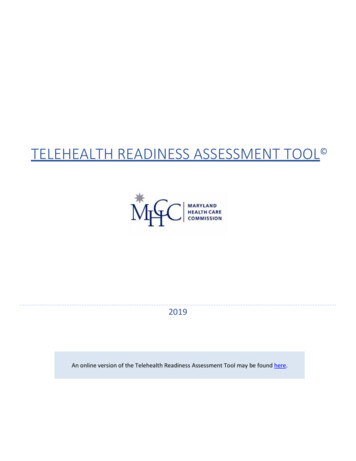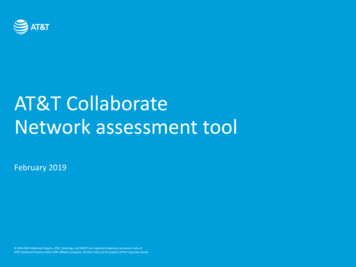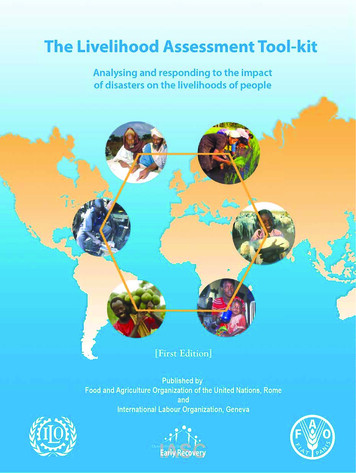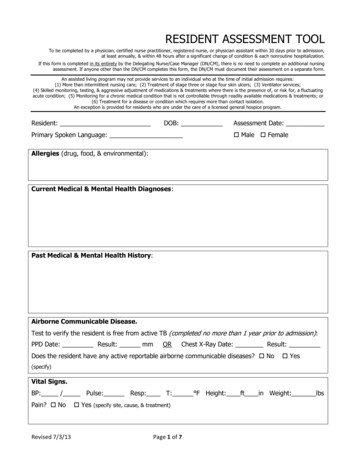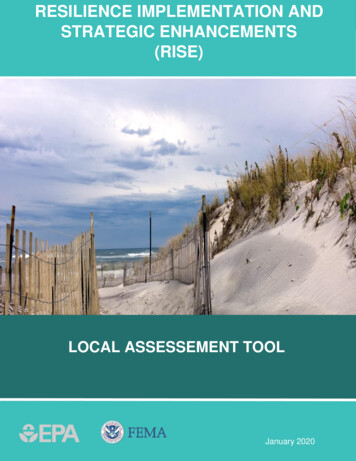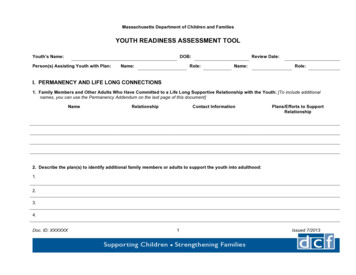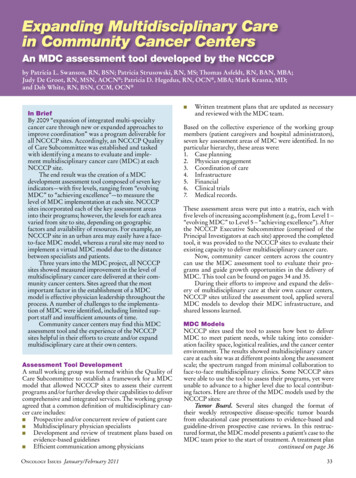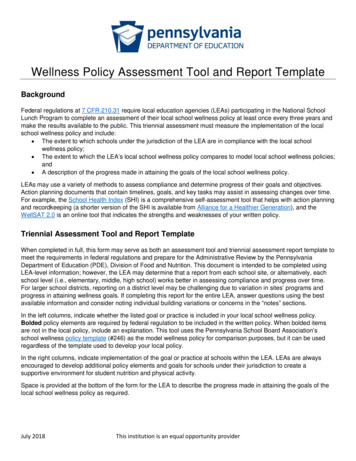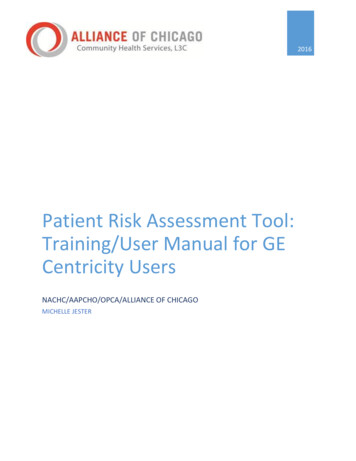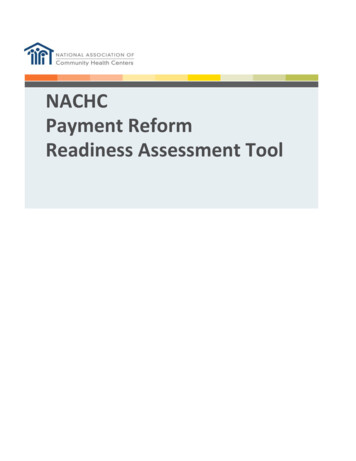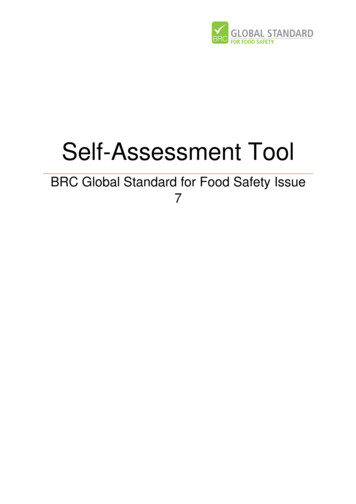
Transcription
Self Assessment ToolBRC Global Standard for Food Safety Issue7
Global Standard for Food SafetyIssue 7: July 2015BRC Global Standards Self-Assessment ToolBRC GLOBAL STANDARD 7 SELF ASSESSMENT TOOLWelcome to the BRC Global Standards Self Assessment toolWe hope that you will find this useful when preparing your site for an audit against the BRC GlobalStandard for Food Safety Issue 7. This tool will be applicable for all BRC Global Standard for FoodSafety audits from the 1st July 2015How to use the BRC Global Standards Self Assessment toolThis tool is designed to help you assess your operation against the requirements of the Standard andhelp prepare you for your certification audit.The checklist covers each of the requirements of the Standard and may be used to check your site’scompliance with each of these requirements. The checklist also allows you to add comments oridentify areas of improvement in the empty boxes provided at the end of each section.While we hope that this tool is useful in helping you prepare for your audit it should not be consideredas evidence of an internal audit and will not be accepted by auditors during an audit.TrainingThe BRC Training Academy has courses available to improve the understanding of the requirementsfor the BRC Global Standard for Food Safety issue 7 and may be useful for the person using the BRCGlobal Standards Self Assessment Tool. For further information on the courses available please visitwww.brctrainingacademy.comFurther InformationIf you have any further questions about the BRC Global Standards Self Assessment Tool or the BRCGlobal Standard for issue 7 please do not hesitate to contact the BRC Global Standards team.Email – enquiries@brcglobalstandards.comTelephone – 020 7854 8939F037aReleased 09/02/2015Self-Assessment ToolPage 1
Global Standard for Food SafetyIssue 7: July 2015BRC Global Standards Self-Assessment Tool1 Senior Management Commitment1.1 Senior Management Commitment and continual NTALStatement of IntentThe site’s senior management shall demonstrate they are fully committed tothe implementation of the requirements of the Global Standard for FoodSafety and to processes which facilitate continual improvement of foodsafety and quality management.1.1.1The site shall have a documented policy which states the site’s intention tomeet its obligation to produce safe and legal products to the specified qualityand its responsibility to its customers. Thisshall be: 1.1.2The site’s senior management shall ensure that clear objectives are definedto maintain and improve the safety, legality and quality of productsmanufactured, in accordance with the food safety and quality policy and thisStandard. These objectives shall be: 1.1.3signed by the person with overall responsibility for the sitecommunicated to all staff .documented and include targets or clear measures of successclearly communicated to relevant staffmonitored and results reported at least quarterly to site seniormanagement.Management review meetings attended by the site’s senior managementshall be undertaken at appropriate planned intervals, annually as aminimum, to review the site performance against theStandard and objectives set in clause 1.1.2. The review process shallinclude the evaluation of: previous management review action plans and timeframesresults of internal, second-party and/or third-party auditscustomer complaints and results of any customer feedbackincidents, corrective actions, out-of-specification results and nonconforming materialsreview of the management of the systems for HACCP, food defenceand authenticityresource requirements.Records of the meeting shall be documented and used to revise theobjectives. The decisions and actions agreed within the review process shallbe effectively communicated to appropriate staff, and actions implementedwithin agreed timescales.F037aReleased 09/02/2015Self-Assessment ToolPage 2
Global Standard for Food SafetyIssue 7: July 2015BRC Global Standards Self-Assessment Tool1.1.4The site shall have a demonstrable meeting programme which enables foodsafety, legality and quality issues to be brought to the attention of seniormanagement at least monthly and allows for the resolution of issuesrequiring immediate action.1.1.5The company’s senior management shall provide the human and financialresources required to produce food safely and in compliance with therequirements of this Standard.1.1.6The company’s senior management shall have a system in place to ensurethat the site is kept informedof and reviews: scientific and technical developmentsindustry codes of practicenew risks to authenticity of raw materialsall relevant legislation applicable in the country of raw materialsupply, production and, where known, the country where the productwill be sold.1.1.7The site shall have a genuine, original hard copy or electronic version of thecurrent Standard available and be aware of any changes to the Standard orprotocol that are published on the BRC website.1.1.8Where the site is certificated to the Standard it shall ensure that announcedrecertification audits occur on or before the audit due date indicated on thecertificate.1.1.9The most senior production or operations manager on site shall participatein the opening and closing meetings of the audit for Global Standard forFood Safety certification. Relevant departmental managers or their deputiesshall be available as required during the audit.1.1.10The site’s senior management shall ensure that the root causes of nonconformities identified at the previous audit against the Standard have beeneffectively addressed to prevent recurrence.Comments/Actions1.2Organisational structure, responsibilities and management authorityStatementof IntentThe company shall have a clear organisational structure and lines of communication toenable effective management of product safety, legality and quality.F037aReleased 09/02/2015Self-Assessment ToolPage 3
Global Standard for Food SafetyIssue 7: July 2015BRC Global Standards Self-Assessment Tool1.2.1The company shall have an organisation chart demonstrating themanagement structure of the company. The responsibilities for themanagement of activities which ensure food safety, legality and quality shallbe clearly allocated and understood by the managers responsible. It shall beclearly documented who deputises in the absence of the responsible person.1.2.2The site’s senior management shall ensure that all employees are aware oftheir responsibilities. Where documented work instructions exist for activitiesundertaken, the relevant employees shall have access to these and be ableto demonstrate that work is carried out in accordance with the instructions.Comments/Actions2 The Food Safety Plan – HACCPFUNDAMENTALStatement ofIntentThe company shall have a fully implemented and effective food safety planbased on Codex Alimentarius HACCP principles.2.1The HACCP food safety team – Codex Alimentarius Step 12.1.1The HACCP plan shall be developed and managed by a multi-disciplinaryfood safety team that includes those responsible for quality/technical,production operations, engineering and other relevant functions.The team leader shall have an in-depth knowledge of HACCP and be able todemonstrate competence and experience. The team members shall havespecific knowledge of HACCP and relevant knowledge of product, processand associated hazards. In the event of the site not having appropriate inhouse knowledge, external expertise may be used, but day-to-daymanagement of the food safety system shall remain the responsibility of thecompany.2.1.2The scope of each HACCP plan, including the products and processescovered, shall be defined.F037aReleased 09/02/2015Self-Assessment ToolPage 4
Global Standard for Food SafetyIssue 7: July 2015BRC Global Standards Self-Assessment ToolComments/Actions2.2Prerequisite programmes2.2.1The site shall establish and maintain environmental and operationalprogrammes necessary to create an environment suitable to produce safeand legal food products (prerequisite programmes). As a guide these mayinclude the following, although this is not an exhaustive list: cleaning and sanitisingpest controlmaintenance programmes for equipment and buildingspersonal hygiene requirementsstaff trainingpurchasingtransportation arrangementsprocesses to prevent cross-contaminationallergen controlsThe control measures and monitoring procedures for the prerequisiteprogrammes must be clearly documented and shall be included within thedevelopment and reviews of the HACCP.Comments/Actions2.3Describe the product – Codex Alimentarius Step 22.3.1A full description for each product or group of products shall be developed,which includes all relevant information on food safety. As a guide, this mayinclude the following, although this is not an exhaustivelist: F037aReleased 09/02/2015composition (e.g. raw materials, ingredients, allergens, recipe)origin of ingredientsphysical or chemical properties that impact food safety (e.g. pH, aw)Self-Assessment ToolPage 5
Global Standard for Food SafetyIssue 7: July 2015BRC Global Standards Self-Assessment Tool 2.3.2treatment and processing (e.g. cooking, cooling)packaging system (e.g. modifi ed atmosphere, vacuum)storage and distribution conditions (e.g. chilled, ambient)target safe shelf life under prescribed storage and usage conditions.All relevant information needed to conduct the hazard analysis shall becollected, maintained, documented and updated. The company will ensurethat the HACCP plan is based on comprehensive information sources, whichare referenced and available on request. As a guide, this may include thefollowing, although this is not an exhaustive list: the latest scientific literaturehistorical and known hazards associated with specific foodproductsrelevant codes of practicerecognised guidelinesfood safety legislation relevant for the production and sale ofproductscustomer requirements.Comments/Actions2.4Identify intended use – Codex Alimentarius Step 32.4.1The intended use of the product by the customer, and any known alternativeuse, shall be described, defining the consumer target groups, including thesuitability of the product for vulnerable groups of the population (e.g. infants,elderly, and allergy sufferers).Comments/Actions2.5Construct a process flow diagram – Codex Alimentarius Step 4F037aReleased 09/02/2015Self-Assessment ToolPage 6
Global Standard for Food SafetyIssue 7: July 2015BRC Global Standards Self-Assessment Tool2.5.1A flow diagram shall be prepared to cover each product, product category orprocess. This shall set out all aspects of the food process operation withinthe HACCP scope, from raw material receipt through to processing, storageand distribution. As a guide, this should include the following, although this isnot an exhaustive list: plan of premises and equipment layoutraw materials including introduction of utilities and other contactmaterials (e.g. water, packaging)sequence and interaction of all process stepsoutsourced processes and subcontracted workpotential for process delayrework and recyclinglow-risk/high-risk/high-care area segregationfinished products, intermediate/semi-processed products, byproducts and waste.Comments/Actions2.6Verify flow diagram – Codex Alimentarius Step 52.6.1The HACCP food safety team shall verify the accuracy of the flow diagramsby on-site audit and challenge at least annually. Daily and seasonalvariations shall be considered and evaluated. Records of verified flowdiagrams shall be maintained.Comments/Actions2.7List all potential hazards associated with each process step, conduct a hazardanalysis and consider any measures to control identified hazards – CodexAlimentarius Step 6, Principle 1F037aReleased 09/02/2015Self-Assessment ToolPage 7
Global Standard for Food SafetyIssue 7: July 2015BRC Global Standards Self-Assessment Tool2.7.1The HACCP food safety team shall identify and record all the potentialhazards that are reasonably expected to occur at each step in relation toproduct, process and facilities. This shall include hazards present in rawmaterials, those introduced during the process or surviving the processsteps, and allergen risks (refer to clause 5.3). It shall also take account of thepreceding and following steps in the process chain.2.7.2The HACCP food safety team shall conduct a hazard analysis to identifyhazards which need to be prevented, eliminated or reduced to acceptablelevels. Consideration shall be given to the following: likely occurrence of hazardseverity of the effects on consumer safetyvulnerability of those exposedsurvival and multiplication of micro-organisms of specific concernto the productpresence or production of toxins, chemicals or foreign bodiescontamination of raw materials, intermediate/semi-processedproduct, or finished product.Where elimination of the hazard is not practical, justification for acceptablelevels of the hazard in the finished product shall be determined anddocumented.2.7.3The HACCP food safety team shall consider the control measures necessaryto prevent or eliminate a food safety hazard or reduce it to an acceptablelevel. Where the control is achieved through existing prerequisiteprogrammes, this shall be stated and the adequacy of the programme tocontrol the specific hazard validated. Consideration may be given to usingmore than one control measure.Comments/Actions2.82.8.1Determine the critical control points (CCP) – Codex Alimentarius Step 7,Principle 2For each hazard that requires control, control points shall be reviewed toidentify those that are critical.This requires a logical approach and may be facilitated by use of a decisiontree. Critical control points (CCPs) shall be those control points which arerequired in order to prevent or eliminate a food safety hazard or reduce it toan acceptable level. If a hazard is identified at a step where c
Issue 7: July 2015 BRC Global Standards Self-Assessment Tool 2.7.1 The HACCP food safety team shall identify and record all the potential hazards that are reasonably expected to occur at each step in relation to product, process and facilities. This shall include hazards present in raw

